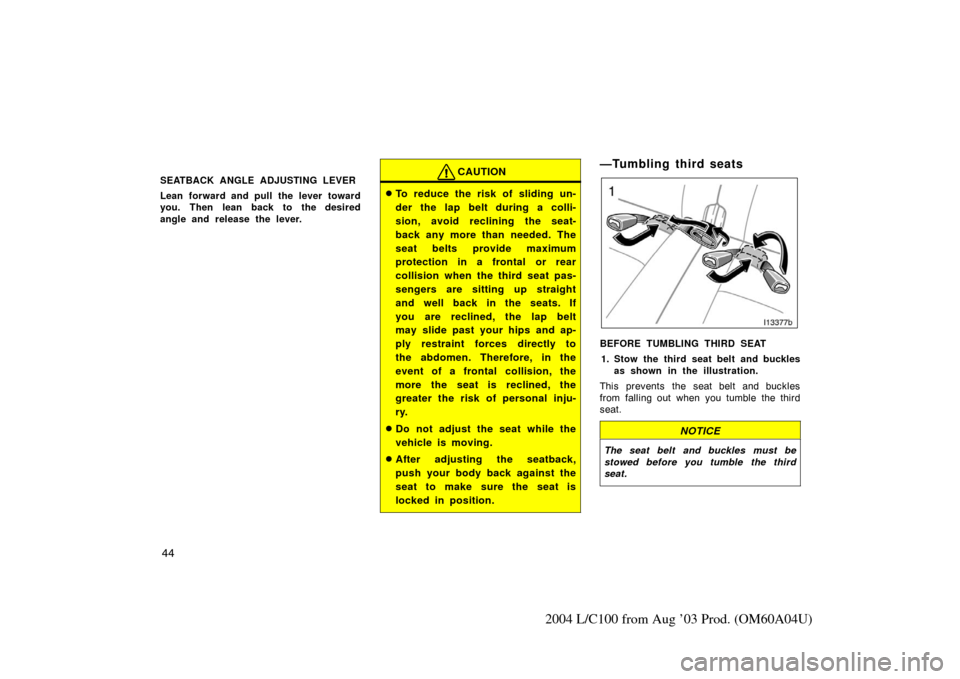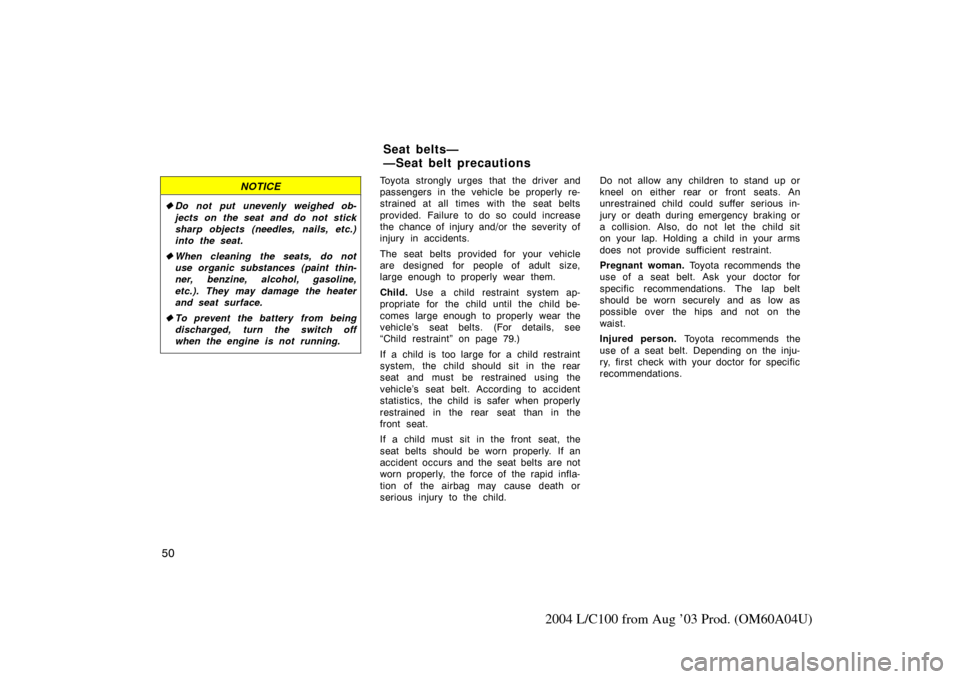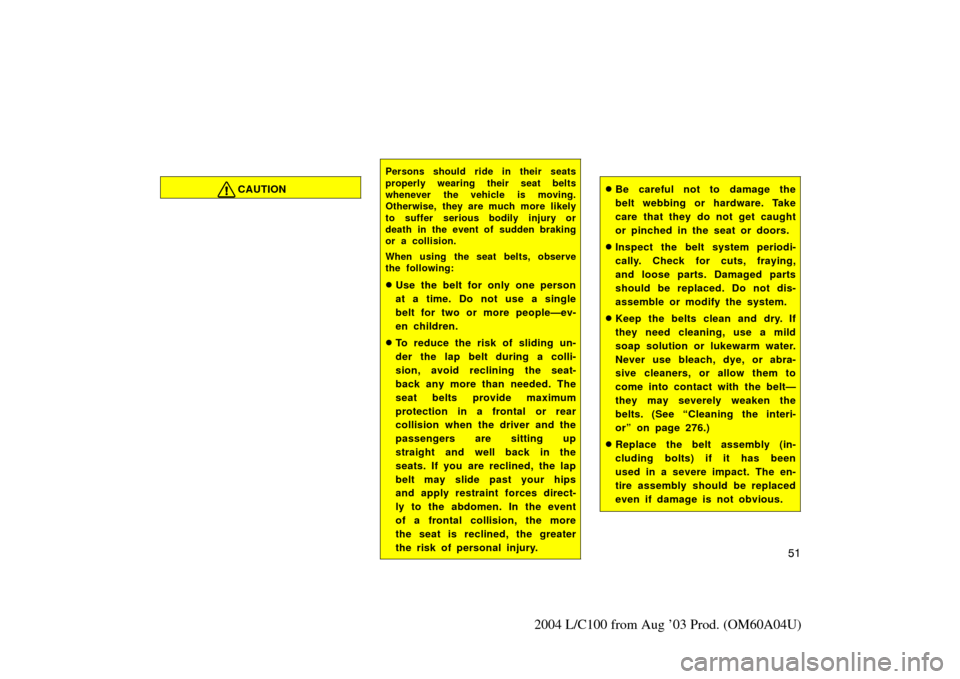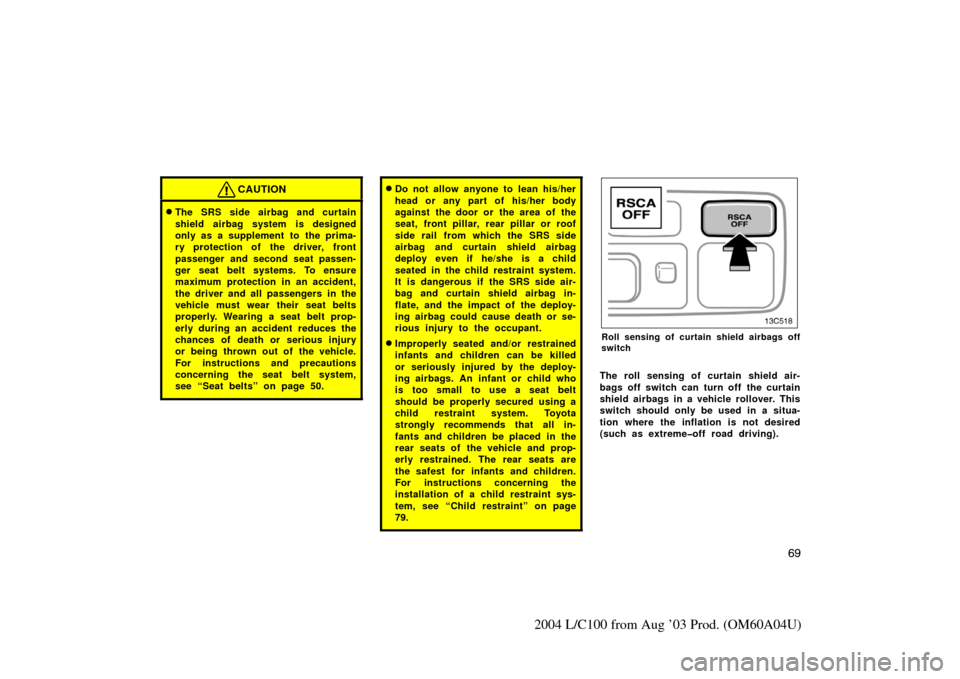Page 49 of 342
41
2004 L/C100 from Aug ’03 Prod. (OM60A04U)
—Tumbling second seat
I13378b
BEFORE TUMBLING SECOND SEAT1. Stow the second seat belt buckles as shown in the illustration.
This prevents the seat belt buckles from
falling out when you tumble the second
seat.
NOTICE
The seat belt buckles must be stowed
before you tumble the second seat.
I13340a
2. Make sure the shoulder belt passes through the hanger when folding the
second seat.
This prevents the shoulder belt from being
damaged.
CAUTION
The seat belt must be removed from
the hanger when the seat belt is in
use.
TUMBLING SECOND SEAT 1. Lower the outer head restraint to the lowest position and pull up the cen-
ter head restraint. Unlock the seat-
back and fold it down.
Tumbling the rear seats will enlarge the
luggage compartment. See “Cargo and
luggage” on page 229 for precautions
when loading luggage.
Page 51 of 342
43
2004 L/C100 from Aug ’03 Prod. (OM60A04U)
WHEN RETURNING THE SECOND SEAT
If you cannot raise the seatback be-
cause of the locked seat belt, do not
try it hard. Release the lock of the seat
belt in the following way. Push in the
lower front edge of the seatback cush-
ion to slacken the seat belt (1) and let
the seat belt retract a little (2).
CAUTION
When returning seats to their original
position, observe the following pre-
cautions in order to prevent personal
injury in a collision or sudden stop:
�Make sure the seat is securely
locked by pushing forward and
rearward on the top of the seat-
back and by trying to pull up
the edge of the bottom cushion.
Failure to do so will prevent seat
belt from operating properly.
�Make sure the seat belts are not
twisted or caught under the seat
and are arranged in their proper
position and are ready to use.
—Adjusting third seats
Page 52 of 342

44
2004 L/C100 from Aug ’03 Prod. (OM60A04U)
SEATBACK ANGLE ADJUSTING LEVER
Lean forward and pull the lever toward
you. Then lean back to the desired
angle and release the lever.CAUTION
�To reduce the risk of sliding un-
der the lap belt during a colli-
sion, avoid reclining the seat-
back any more than needed. The
seat belts provide maximum
protection in a frontal or rear
collision when the third seat pas-
sengers are sitting up straight
and well back in the seats. If
you are reclined, the lap belt
may slide past your hips and ap-
ply restraint forces directly to
the abdomen. Therefore, in the
event of a frontal collision, the
more the seat is reclined, the
greater the risk of personal inju-
ry.
�Do not adjust the seat while the
vehicle is moving.
�After adjusting the seatback,
push your body back against the
seat to make sure the seat is
locked in position.
—Tumbling third seats
I13377b
BEFORE TUMBLING THIRD SEAT
1. Stow the third seat belt and buckles as shown in the illustration.
This prevents the seat belt and buckles
from falling out when you tumble the third
seat.
NOTICE
The seat belt and buckles must be
stowed before you tumble the third
seat.
Page 53 of 342
45
2004 L/C100 from Aug ’03 Prod. (OM60A04U)
I13262b
2. Make sure the shoulder belt passesthrough the hanger when folding the
third seat.
This prevents the shoulder belt from being
damaged.
CAUTION
The seat belt must be removed from
the hanger when the seat belt is in
use.
TUMBLING THIRD SEAT 1. Lower the head restraint to the low- est position. Unlock the seatback
and fold it down.
Tumbling the third seats will enlarge the
luggage compartment. See “Cargo and
luggage” on page 229 for precautions
when loading luggage.2. Unlock the seat cushion and slide the whole seat to the rear�most
position while pulling up the handle.
Page 55 of 342

47
2004 L/C100 from Aug ’03 Prod. (OM60A04U)
CAUTION
When returning seats to their original
position, observe the following pre-
cautions in order to prevent personal
injury in a collision or sudden stop:
�Make sure the seat is securely
locked by pushing forward and
rearward on the top of the seat-
back and by trying to pull up
the edge of the bottom cushion.
Be certain to replace head re-
straint. Failure to do so will pre-
vent seat belt from operating
properly.
�Make sure the seat belts are not
twisted or caught under the seat
and are arranged in their proper
position and are ready to use.
—Removing third seats
After tumbling the third seat, open the
cover, hold the whole seat and pull it
up while pulling the handle toward you.
Removing the third seat will enlarge the
luggage compartment. See “Cargo and
luggage” on page 229 for precautions
when loading luggage.Remove the seat hook covers from the
back of the seat cushion, and install
them over the seat hooks.
CAUTION
Be sure to apply the covers on the
seat hooks, or you may get burned
when they become hot.
When returning the third seat to its origi-
nal position, remove the seat hook covers
from the floor and install them in the back
of the seat cushion.
Page 58 of 342

50
2004 L/C100 from Aug ’03 Prod. (OM60A04U)
NOTICE
�Do not put unevenly weighed ob-
jects on the seat and do not stick
sharp objects (needles, nails, etc.)
into the seat.
� When cleaning the seats, do not
use organic substances (paint thin-
ner, benzine, alcohol, gasoline,
etc.). They may damage the heater
and seat surface.
� To prevent the battery from being
discharged, turn the switch off
when the engine is not running.
Toyota strongly urges that the driver and
passengers in the vehicle be properly re-
strained at all times with the seat belts
provided. Failure to do so could increase
the chance of injury and/or the severity of
injury in accidents.
The seat belts provided for your vehicle
are designed for people of adult size,
large enough to properly wear them.
Child. Use a child restraint system ap-
propriate for the child until the child be-
comes large enough to properly wear the
vehicle’s seat belts. (For details, see
“Child restraint” on page 79.)
If a child is too large for a child restraint
system, the child s hould sit in the rear
seat and must be restrained using the
vehicle’s seat belt. According to accident
statistics, the child is safer when properly
restrained in the rear seat than in the
front seat.
If a child must sit in the front seat, the
seat belts should be worn properly. If an
accident occurs and the seat belts are not
worn properly, the force of the rapid infla-
tion of the airbag may cause death or
serious injury to the child. Do not allow any children to stand up or
kneel on either rear or front seats. An
unrestrained child could suffer serious in-
jury or death during emergency braking or
a collision. Also, do not let the child sit
on your lap. Holding a child in your arms
does not provide sufficient restraint.
Pregnant woman.
Toyota recommends the
use of a seat belt. Ask your doctor for
specific recommendations. The lap belt
should be worn securely and as low as
possible over the hips and not on the
waist.
Injured person. Toyota recommends the
use of a seat belt. Depending on the inju-
ry, first check with your doctor for specific
recommendations.
Seat belts—
—Seat belt precautions
Page 59 of 342

51
2004 L/C100 from Aug ’03 Prod. (OM60A04U)
CAUTION
Persons should ride in their seats
properly wearing their seat belts
whenever the vehicle is moving.
Otherwise, they are much more likely
to suffer serious bodily injury or
death in the event of sudden braking
or a collision.
When using the seat belts, observe
the following:
�Use the belt for only one person
at a time. Do not use a single
belt for two or more people—ev-
en children.
�To reduce the risk of sliding un-
der the lap belt during a colli-
sion, avoid reclining the seat-
back any more than needed. The
seat belts provide maximum
protection in a frontal or rear
collision when the driver and the
passengers are sitting up
straight and well back in the
seats. If you are reclined, the lap
belt may slide past your hips
and apply restraint forces direct-
ly to the abdomen. In the event
of a frontal collision, the more
the seat is reclined, the greater
the risk of personal injury.
�Be careful not to damage the
belt webbing or hardware. Take
care that they do not get caught
or pinched in the seat or doors.
�Inspect the belt system periodi-
cally. Check for cuts, fraying,
and loose parts. Damaged parts
should be replaced. Do not dis-
assemble or modify the system.
�Keep the belts clean and dry. If
they need cleaning, use a mild
soap solution or lukewarm water.
Never use bleach, dye, or abra-
sive cleaners, or allow them to
come into contact with the belt—
they may severely weaken the
belts. (See “Cleaning the interi-
or” on page 276.)
�Replace the belt assembly (in-
cluding bolts) if it has been
used in a severe impact. The en-
tire assembly should be replaced
even if damage is not obvious.
Page 77 of 342

69
2004 L/C100 from Aug ’03 Prod. (OM60A04U)
CAUTION
�The SRS side airbag and curtain
shield airbag system is designed
only as a supplement to the prima-
ry protection of the driver, front
passenger and second seat passen-
ger seat belt systems. To ensure
maximum protection in an accident,
the driver and all passengers in the
vehicle must wear their seat belts
properly. Wearing a seat belt prop-
erly during an accident reduces the
chances of death or serious injury
or being thrown out of the vehicle.
For instructions and precautions
concerning the seat belt system,
see “Seat belts” on page 50.
�Do not allow anyone to lean his/her
head or any part of his/her body
against the door or the area of the
seat, front pillar, rear pillar or roof
side rail from which the SRS side
airbag and curtain shield airbag
deploy even if he/she is a child
seated in the child restraint system.
It is dangerous if the SRS side air-
bag and curtain shield airbag in-
flate, and the impact of the deploy-
ing airbag could cause death or se-
rious injury to the occupant.
�Improperly seated and/or restrained
infants and children can be killed
or seriously injured by the deploy-
ing airbags. An infant or child who
is too small to use a seat belt
should be properly secured using a
child restraint system. Toyota
strongly recommends that all in-
fants and children be placed in the
rear seats of the vehicle and prop-
erly restrained. The rear seats are
the safest for infants and children.
For instructions concerning the
installation of a child restraint sys-
tem, see “Child restraint” on page
79.Roll sensing of curtain shield airbags off
switch
The roll sensing of curtain shield air-
bags off switch can turn off the curtain
shield airbags in a vehicle rollover. This
switch should only be used in a situa-
tion where the inflation is not desired
(such as extreme�off road driving).